
Jan de Molder (sometimes Jean de Molder, fl. 1494-1550) [1] was a Northern Renaissance wood carver active in Antwerp in the early 16th century. His work represents the beginnings of Antwerp Mannerism. [2]

Jan de Molder (sometimes Jean de Molder, fl. 1494-1550) [1] was a Northern Renaissance wood carver active in Antwerp in the early 16th century. His work represents the beginnings of Antwerp Mannerism. [2]
Very little is known about the life of Jan de Molder. He was active in Antwerp and was brother-in-law of a prior of Averbode Abbey named Adriaen. Works of his hand survive in the Cluny Museum in Paris [3] and in the churches of Botkyrka, Dillnäs, Lofta and Västerlövsta churches, Sweden. [4]
The artist is known only for the production of two carved altarpieces for the abbey of Averbode. The first one commissioned in 1513 is an altarpiece bearing the Antwerp mark of quality and the arms of the abbey of Averbode now in the Cluny Museum in Paris. The carved scenes are identical with those specified in the Averbode contract. The second altarpiece is lost. [2]
The style of the Cluny altarpiece shows the beginnings of Antwerp Mannerism in its elaborate and arched frame and the crowded compositions. The compact and animated figure types, unaffected gestures and angular drapery are regarded as more characteristic of late 15th-century sculpture. [3]
Other characteristics are visible in a polyptych in the collection of the National Museum in Warsaw - so-called Saint Reinhold Altar. [5] 10 scenes from the life of Mary arranged in 2 rows with additional 4 sections with figures of Saints were crowned by architectural decorations in the form of curved tracery. The top of the retable in variety of curves and accolades, as well as disproportionality of figures are other features of de Molder's style. Oak wood, used for production, was covered with a coating of gesso (size and chalk) over which gold leaf and colour were laid. [5] The polyptych was commissioned by Brotherhood of Saint Reinhold in Gdańsk and created before 1516 in cooperation with Joos van Cleve who painted the side wings. [5]

An altarpiece is an artwork such as a painting, sculpture or relief representing a religious subject made for placing behind the altar of a Christian church. Though most commonly used for a single work of art such as a painting or sculpture, or a set of them, the word can also be used of the whole ensemble behind an altar, otherwise known as a reredos, including what is often an elaborate frame for the central image or images. Altarpieces were one of the most important products of Christian art especially from the late Middle Ages to the era of the Counter-Reformation.

A predella is the platform or step on which an altar stands. In painting, the predella is the painting or sculpture along the frame at the bottom of a polyptych or multipanel altarpiece. In later Christian medieval and Renaissance altarpieces, where the main panel consisted of a scene with large static figures, it was normal to include a predella below with a number of small-scale narrative paintings depicting events from the life of the dedicatee, whether the Life of Christ, the Life of the Virgin or a saint. Typically there would be three to five small scenes, in a horizontal format.

Jan Gossaert was a French-speaking painter from the Low Countries also known as Jan Mabuse or Jennyn van Hennegouwe (Hainaut), as he called himself when he matriculated in the Guild of Saint Luke, at Antwerp, in 1503. He was one of the first painters of Dutch and Flemish Renaissance painting to visit Italy and Rome, which he did in 1508–09, and a leader of the style known as Romanism, which brought elements of Italian Renaissance painting to the north, sometimes with a rather awkward effect. He achieved fame across at least northern Europe, and painted religious subjects, including large altarpieces, but also portraits and mythological subjects, including some nudity.

Gothic art was a style of medieval art that developed in Northern France out of Romanesque art in the 12th century AD, led by the concurrent development of Gothic architecture. It spread to all of Western Europe, and much of Northern, Southern and Central Europe, never quite effacing more classical styles in Italy. In the late 14th century, the sophisticated court style of International Gothic developed, which continued to evolve until the late 15th century. In many areas, especially Germany, Late Gothic art continued well into the 16th century, before being subsumed into Renaissance art. Primary media in the Gothic period included sculpture, panel painting, stained glass, fresco and illuminated manuscripts. The easily recognizable shifts in architecture from Romanesque to Gothic, and Gothic to Renaissance styles, are typically used to define the periods in art in all media, although in many ways figurative art developed at a different pace.

In art, a sacra conversazione, meaning holyconversation, is a genre developed in Italian Renaissance painting, with a depiction of the Virgin and Child amidst a group of saints in a relatively informal grouping, as opposed to the more rigid and hierarchical compositions of earlier periods. Donor portraits may also be included, generally kneeling, often their patron saint is presenting them to the Virgin, and angels are frequently in attendance.
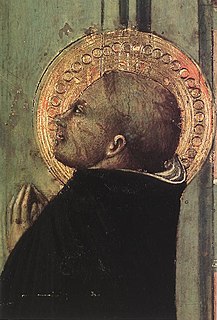
For the village near Livorno, see Sassetta, Tuscany
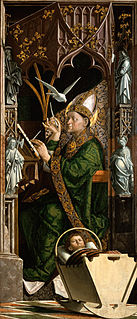
Michael Pacher was a painter and sculptor from Tyrol active during the second half of the fifteenth century. He was one of the earliest artists to introduce the principles of Renaissance painting into Germany. Pacher was a comprehensive artist with a broad range of sculpting, painting, and architecture skills producing works of complex wood and stone. He painted structures for altarpieces on a scale unparalleled in North European art.

Antwerp Mannerism is the name given to the style of a group of largely anonymous painters active in the Southern Netherlands and principally in Antwerp in roughly the first three decades of the 16th century, a movement marking the tail end of Early Netherlandish painting, and an early phase within Dutch and Flemish Renaissance painting. The style bore no relation to Italian Mannerism, which it mostly predates by a few years, but the name suggests that it was a reaction to the "classic" style of the earlier Flemish painters, just as the Italian Mannerists were reacting to, or trying to go beyond, the classicism of High Renaissance art.
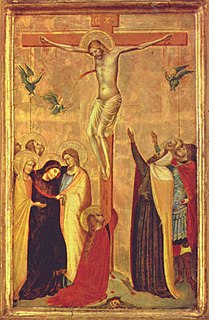
Bernardo Daddi was an early Italian Renaissance painter and the leading painter of Florence of his generation. He was one of the artists who contributed to the revolutionary art of the Renaissance, which broke away from the conventions of the preceding generation of Gothic artists, by creating compositions which aimed to achieve a more realistic representation of reality. He was particularly successful with his small-scale works and contributed to the development of the portable altarpiece, a format that subsequently gained great popularity.
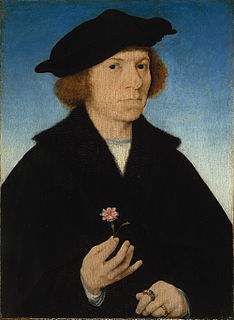
Joos van Cleve was a leading painter active in Antwerp from his arrival there around 1511 to his death in 1540 or 1541. Within Dutch and Flemish Renaissance painting, he combines the traditional techniques of Early Netherlandish painting with influences of more contemporary Renaissance painting styles.

Melchior Broederlam was one of the earliest Early Netherlandish painters to whom surviving works can be confidently attributed. He worked mostly for Philip the Bold, Duke of Burgundy, and is documented from 1381 to 1409. Although only a single large pair of panel paintings can confidently be attributed to him, no history of Western painting can neglect his contribution.

Jan de Beer, formerly known as the Master of the Milan Adoration was a Flemish painter, draughtsman and glass designer active in Antwerp at the beginning of the 16th century. He is considered one of the most important members of the loose group of painters active in and around Antwerp in the early 16th century referred to as the Antwerp Mannerists. Highly respected in his time, he operated a large workshop with an important output of religious compositions.
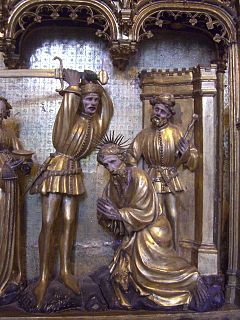
Jacques de Baerze was a Flemish sculptor in wood, two of whose major carved altarpieces survive in Dijon, now in France, then the capital of the Duchy of Burgundy.
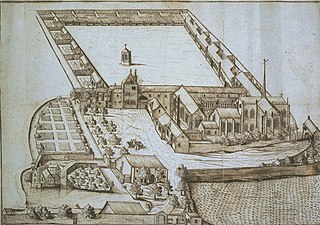
The Chartreuse de Champmol, formally the Chartreuse de la Sainte-Trinité de Champmol, was a Carthusian monastery on the outskirts of Dijon, which is now in France, but in the 15th century was the capital of the Duchy of Burgundy. The monastery was founded in 1383 by Duke Philip the Bold to provide a dynastic burial place for the Valois Dukes of Burgundy, and operated until it was dissolved in 1791, during the French Revolution. Called "the grandest project in a reign renowned for extravagance", it was lavishly enriched with works of art, and the dispersed remnants of its collection remain key to the understanding of the art of the period.

Colijn de Coter was an early Netherlandish painter who produced mainly altarpieces. He worked primarily in Brussels and Antwerp. His name was sometimes given as Colijn van Brusele, indicating that he hailed from Brussels or at the least lived there most of his active life. He also signed several paintings with Coliin de Coter pinxit me in Brabancia Bruselle.

Jan Borman was a Flemish Northern renaissance sculptor.

Jan Rombouts the Elder, Jan Rombouts (I), was a Flemish Renaissance painter, glass painter, draftsman, printmaker and glass designer. The subjects of his work are stories from the Old and New Testament and the lives of Christian saints. He was active in Leuven where he introduced the Renaissance innovations of Bernard van Orley and the Antwerp school.

Gothic boxwood miniatures are very small Christian wood sculptures produced during the 15th and 16th centuries in the Low Countries, at the end of the Gothic period and during the emerging Northern Renaissance. They consist of highly intricate layers of reliefs, often rendered to nearly microscopic level, and are made from boxwood, which has a fine grain and high density suitable for detailed micro-carving. There are around 150 surviving examples; most are spherical rosary beads, statuettes, skulls, or coffins; some 20 are in the form of polyptychs, including triptych and diptych altarpieces, tabernacles and monstrances. The polyptychs are typically 10–13 cm in height. Most of the beads are 10–15 cm in diameter and designed so they could be held in the palm of a hand, hung from necklaces or belts, or worn as fashionable accessories.

Adriaen van Overbeke, Adrian van Overbeck and Adriaen van Overbeke was a Flemish Renaissance painter in the style of Antwerp Mannerism. He operated a large workshop with an important output of altarpieces, which were mainly exported to Northern France, the Rhineland and Westphalia. His known works were predominantly polychromed wooden altarpieces with painted shutters, which were created through a collaboration between painters and sculptors.

The Master of the Von Groote Adoration is a notname given to an artist or a number of artists or various workshops active in Antwerp sometime between 1500 and 1520. Whereas there are significant variations in the style of the works attributed to the master, the repetitions of certain subjects played an important role in the composition of the oeuvre. The master is considered a representative of the group of Antwerp mannerists who created works in an extravagant style in the early sixteenth century.